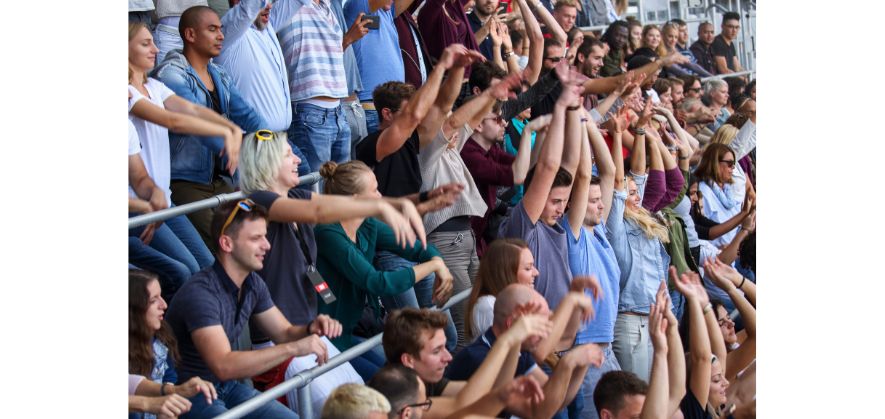The 2022 FIFA World Cup is just about to roll around and fan excitement levels for those who watch the sport are arguably edging towards fever pitch.
After all, this is probably the last international tournament where we’ll get to witness two legends of the game in Cristiano Ronaldo and Lionel Messi.
Both players are in the twilight years of their professional years and Qatar presents possibly the final chance for Lionel Messi to cement his claim as being the greatest player of all time.
Crowds within Qatar’s eight venues are going to be ready to support their teams, and at a tournament such as this you can expect fans to get involved in actions like the Mexican wave.
If you’ve viewed your fair share of international games during the biggest tournaments that soccer has to offer, then you know that a Mexican wave will be on its way long before it surfaces.
But why is this the case?
More specifically, why is this rhythmic yet methodical action of rising from one’s seat and hurling both arms above the head before sitting back down again so commonplace at international fixtures?
Well, the answer is actually quite sad to talk about.
Nonetheless, this article will break down exactly why soccer fans like to engage in the Mexican wave, offering insight into its origin and the motivations behind it.
Let’s start with a quick summary…
Soccer fans typically perform the Mexican wave when they have lost interest in the on-pitch proceedings taking place before them. The action is meant to rally the crowd and create a sense of excitement for those in the stands.
Now, we shall dig a little bit deeper into this topic.
Read on to learn more.
What is the meaning of the Mexican wave?
To begin with, there is a succinct definition for this term that you should be aware of:
“Scientifically, it is described as an example of metachronal rhythm achieved in a packed stadium when successive groups of spectators briefly stand, yell, and raise their arms, creating a moving wave travelling around the stadium.”
Source – Eastern Daily Press
Essentially, it’s a sequence of separate actions combining together, resulting in a visually appealing spectacle for television viewers as cameras pan to the wave and watch it move smoothly from one end of a stadium to another.
Here’s a video which showcases exactly what a Mexican wave looks like:
Why do people do the wave at stadiums?
Spectators like to get involved in the Mexican wave for a variety of reasons.
The article will now cover a few of these in turn.
1. Curing boredom

Over the years, international fixtures have a reputation for not being as interesting as games that take place in domestic divisions like the Premier League or La Liga.
Particularly in England’s highest tier of the soccer pyramid, teams play at a frantic pace and that generates a lot of excitement for fans who love the chaos brought about by end-to-end action.
On the other hand at international level, matches tend to be played at a slower pace and this can frustrate the crowd who have paid a pretty penny to come and watch.
Games at tournaments like the European championships and the World Cup are dominated by aspects like:
- Solid defensive structure;
- Patient and safe ball progression; as well as
- Heavy emphasis on maximizing set piece threat
These slow patterns of play can be quite dull for fans who were prepared to be stimulated by fancy dribbles, exquisite flair and numerous soccer balls flying into the back of the net.
Consequently, the Mexican wave is sort of used as a welcome distraction for spectators who want to generate some excitement.
It’s not an action that is directed as a protest at the players, in fact far from it.
The wave just helps to get the crowd going, especially when the performance and quality of the game taking place on the pitch fails to live up to expectations.
2. Joy in being part of something bigger

The second reason is actually a polar opposite of the first.
This is because the Mexican wave can be viewed as a celebration.
When nearly every member of the crowd in a stadium stands up and raises their arms over their heads, it showcases a sense of inclusivity.
Everyone does their part to keep the wave going, regardless of their team affiliations or even other things like race, gender or economic status.
There’s pretty much no unwilling participant as everyone likes to get involved in the action when it happens.
So, fans like to participate in the wave as it makes them feel like they are part of something really special.
Where did the Mexican wave come from?
The action gets its name from the 1986 FIFA World Cup which took place in…
You guessed it…
Mexico!
Many soccer commentators are able to give their own personal accounts with the vast majority saying that the wave originated from this tournament which took place in 1986.
But it’s also said that the wave featured in American sports game like baseball years before it ascended to global popularity in Mexico.
The wave is said to have started to appear at North American sporting events in the late 1970s, with the first video documentation of the action was recorded at a Major League Baseball fixture in 1981.
And just a couple of years after its introduction, the move garnered global attention at the 1986 World Cup in Mexico, where it was repeated many times during most matches.
So, now you can see why it’s called the Mexican wave.
Coinage of the term simply stems from the 1986 World Cup tournament in Mexico.
However, not everyone refers to this action as the Mexican wave.
People from the United Kingdom call it that because they first came across it at that particular World Cup.
But Americans who had prior knowledge of the action like to describe it as “The Wave”, whereas Mexicans themselves mostly refer to it in their own language as “La Ola”.
What is the longest Mexican wave ever recorded?
A quick Google is able to tell us that the longest Mexican wave lasted approximately 27 minutes at the Rocket League World Championships.
Here’s a clip that shows a sneak preview of how this was achieved:
The record previously stood at 17 minutes and 14 seconds as a total of 2,115 people participated in one at a concert in Japan’s Hanshin Koshien Stadium on the 23rd of September, 2015.
In terms of the largest number of people involved in a Mexican wave, this no doubt comes from the pre-season clash in the United States between Manchester United and Real Madrid which took place in front of a massive 109,901 capacity crowd.
Check out the footage below for a glimpse of what that particular wave looked like:
Is the Mexican wave offensive?
The Mexican wave certainly isn’t meant to be offensive in any shape or form.
It isn’t directed at any players, or coaches for that matter, as its simply a way for fans to express themselves as they watch the action from the stands.
On a separate note, some of these stadiums can be pretty cold and as a fan you wouldn’t want to be glued to your seat for the entirety of the fixture, or else you’d freeze!
Ultimately, the Mexican wave isn’t a slight on any player as it exists to keep fans active and involved in the spectacle even as they spectate from the stands.
Conclusion
If you’ve enjoyed reading through this piece, then you’re probably also going to love our articles covering some other parts of soccer fandom such as:
- Why soccer fans turn their backs to face the pitch during matches;
- Why soccer fans like to sing songs in the stadium; and
- Why soccer fans shout “Ole” during matches
If you enjoy the content that I create and would like to buy me a coffee, then I’d really appreciate it!
Any money that I earn through this donation will be re-invested into more content for this website.
Additionally, by sending in a donation you’ll also receive a copy of my recently released 190+ page eBook on Soccer Ball Care, as well as be subscribed to our mailing list where you’ll be regularly informed on the latest developments concerning the Soccer Whizz blog.
- Future Icons: Europe’s Emerging Midfield Maestros Set for Glory - December 4, 2023
- Kickstarting a Revolution: How Soccer Transformed the United States Over the Last Four Years - October 7, 2023
- 4-1-4-1 Soccer Formation [Analysis] - September 23, 2023

